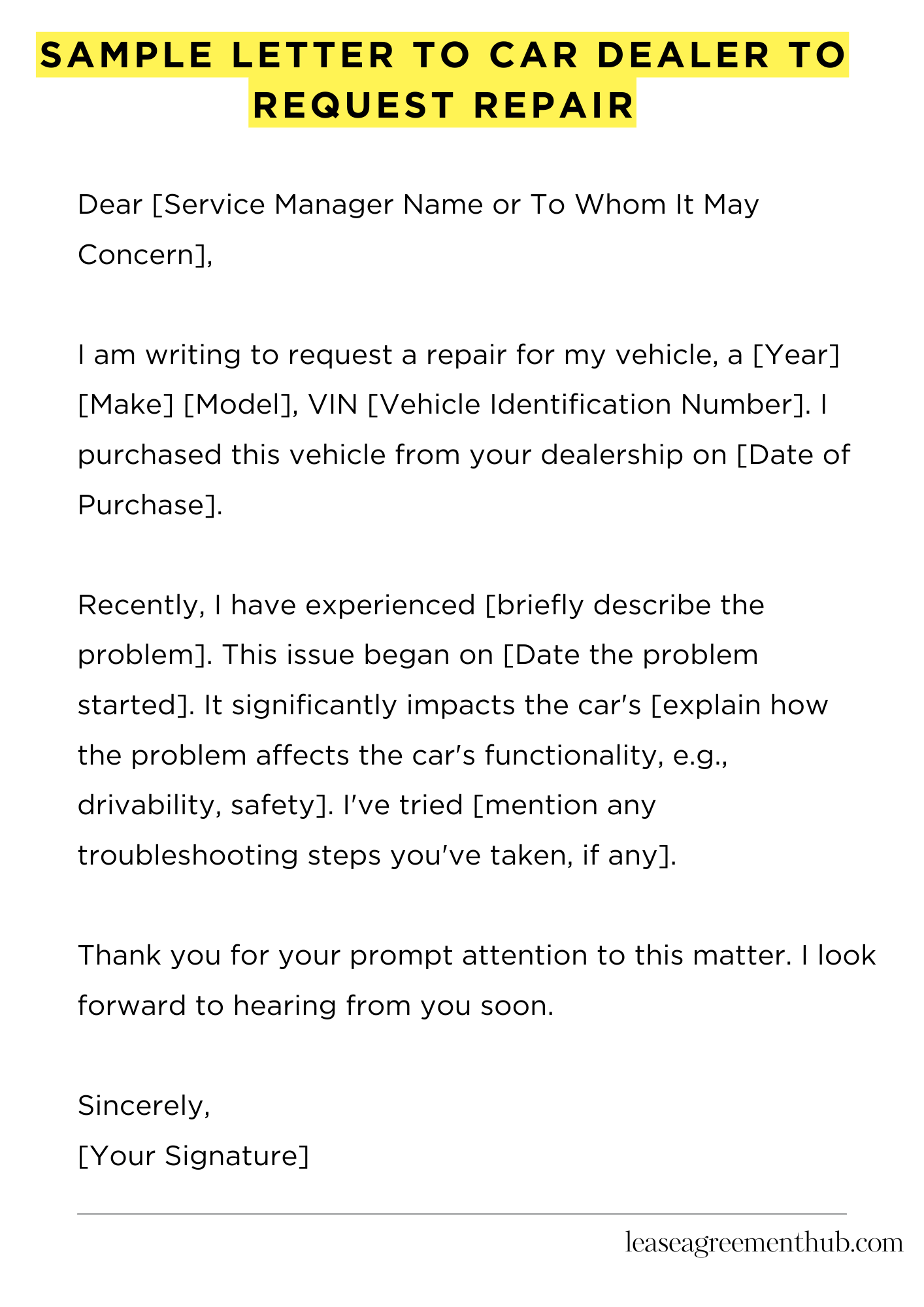This article is about letters. These letters ask car dealers for repairs. They’re for when your car has problems.
We’ll give you examples of these letters. They are templates. You can use them as a starting point.
Use our samples to write your own. It makes writing the letter easier. You’ll save time and effort.
Sample Letter to Car Dealer to Request Repair
[Your Name]
[Your Address]
[Your Phone Number]
[Your Email Address]
[Date]
[Dealer Name]
[Dealer Address]
Dear [Service Manager Name or To Whom It May Concern],
I am writing to request a repair for my vehicle, a [Year] [Make] [Model], VIN [Vehicle Identification Number]. I purchased this vehicle from your dealership on [Date of Purchase].
Recently, I have experienced [briefly describe the problem]. This issue began on [Date the problem started]. It significantly impacts the car’s [explain how the problem affects the car’s functionality, e.g., drivability, safety]. I’ve tried [mention any troubleshooting steps you’ve taken, if any].
I would appreciate it if you could schedule an appointment for my vehicle to be inspected and repaired as soon as possible. Please let me know your availability and what documentation I need to bring with me. I expect the repair to be covered under warranty as the vehicle is still under its warranty period. A copy of my warranty is attached.
Thank you for your prompt attention to this matter. I look forward to hearing from you soon.
Sincerely,
[Your Signature]

How to Write a Sample Letter to Car Dealer to Request Repair
Laying the Foundation: Establishing Your Case
Before you even think about putting pen to paper (or fingers to keyboard), meticulously gather all pertinent information. This includes your vehicle’s identification number (VIN), the date of purchase, a detailed description of the malfunction, and any relevant warranty information. A poorly documented complaint is a recipe for protracted negotiations and frustration. Thorough documentation is paramount.
Crafting a Cogent Salutation: Setting the Tone
Avoid overly familiar or informal greetings. A simple and professional “Dear [Dealership Manager Name],” is always appropriate. If you don’t know the manager’s name, use “Dear Sir/Madam,”. This initial formality establishes a respectful tone crucial for securing a favorable response. Impeccable etiquette is essential.
Articulating the Problem: Clarity is King
Clearly and concisely describe the problem with your vehicle. Use precise, unambiguous language, eschewing jargon unless you’re certain the recipient understands it. Instead of saying “the car is making a weird noise,” try “a high-pitched whine emanating from the engine compartment is audible at speeds exceeding 40 mph.” Specificity is key to effective communication.
Providing Supporting Evidence: Corroborating Your Claims
Include any supporting documentation, such as repair orders from previous attempts to fix the issue, photos or videos showing the problem, or witness statements. The more evidence you can provide, the stronger your case becomes. This bolsters your credibility and expedites the resolution process.
Stating Your Desired Resolution: Setting Expectations
Clearly state what you expect the dealership to do to rectify the situation. Do you want a repair, a refund, a replacement vehicle? Be specific, realistic, and reasonable in your request. Ambiguity will only prolong the process. Direct communication is paramount.
Concluding with Professionalism: Leaving a Lasting Impression
End your letter with a polite closing, such as “Sincerely,” or “Respectfully,” followed by your typed name, contact information, and a legible signature. A well-crafted conclusion reinforces your professionalism and leaves a lasting positive impression. Attention to detail differentiates a proficient correspondent.
Post-Dispatch Protocols: Following Up
After sending your letter, keep a copy for your records and follow up with a phone call after a reasonable timeframe (e.g., a week). This demonstrates your proactive engagement and ensures your request doesn’t get lost in the administrative labyrinth. Persistent, yet polite, follow-up is often essential.
FAQs about sample letter to car dealer to request repair
Writing an effective letter to a car dealer requesting repairs can be challenging. Here are five frequently asked questions to help guide you.
What information should I include in my letter?
Your letter should clearly state the problem with your vehicle, including specific details like the make, model, year, and VIN. Mention when the issue started and any attempts you’ve made to resolve it. Include your contact information and the date of purchase or service if applicable. Finally, state what repair you expect the dealer to perform and if you expect any compensation such as a refund or parts replacement.
How formal should the tone of my letter be?
Maintain a professional and polite tone throughout your letter. Avoid accusatory or demanding language. A respectful approach is more likely to result in a positive response from the dealer. While you should be firm in expressing your needs, maintain a courteous and reasonable tone.
Should I send the letter by mail or email?
While email is often quicker, sending your letter via certified mail with return receipt requested can provide proof of delivery and receipt, which can be important if you need to escalate the matter later. Check the dealer’s preferred method of contact; some dealers may have specific contact procedures outlined on their website.
What if the dealer refuses the repair?
If the dealer refuses your repair request, review your warranty or purchase agreement carefully. If you believe the dealer is in breach of contract, consider consulting a lawyer or contacting your state’s consumer protection agency for guidance. Keep copies of your letter and any other relevant documentation.
What should I do if I don’t receive a response?
If you don’t receive a response within a reasonable timeframe (typically a week or two), follow up with a phone call or another letter. If you still don’t get a response, consider escalating the issue to a higher authority within the dealership or pursuing other legal options.
Related: